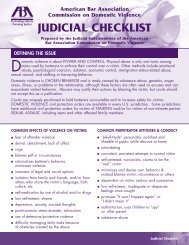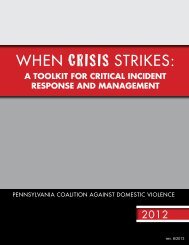December 2012 - Pennsylvania Coalition Against Domestic Violence
December 2012 - Pennsylvania Coalition Against Domestic Violence
December 2012 - Pennsylvania Coalition Against Domestic Violence
Create successful ePaper yourself
Turn your PDF publications into a flip-book with our unique Google optimized e-Paper software.
Introduction to the <strong>Violence</strong> <strong>Against</strong> Women Act Certifications<br />
Written by: PCADV Legal Department<br />
Each year, <strong>Pennsylvania</strong> receives millions of dollars in federal funds awarded by the U.S. Department of<br />
Justice, Office on <strong>Violence</strong> <strong>Against</strong> Women. Some of this funding is authorized through the STOP<br />
program in the federal <strong>Violence</strong> <strong>Against</strong> Women Act (VAWA). STOP funds are awarded through a<br />
formula grant to states across the country. The <strong>Pennsylvania</strong> Commission on Crime and Delinquency<br />
(PCCD), as <strong>Pennsylvania</strong>’s STOP state administrator, distributes the funding to <strong>Pennsylvania</strong> law<br />
enforcement, prosecution, victim services and courts consistent with the funding priorities established<br />
in VAWA and as set forth in <strong>Pennsylvania</strong>’s STOP Implementation Plan.<br />
In order to receive this funding, the Commonwealth of <strong>Pennsylvania</strong>, as well as any local <strong>Pennsylvania</strong><br />
jurisdiction receiving a STOP funding award, certifies that under its laws, policies and practices:<br />
<br />
<br />
<br />
<br />
<strong>Domestic</strong> violence victims do not pay to file a Protection From Abuse Petition or criminal<br />
charges;<br />
<strong>Domestic</strong> violence offenders receive judicial notification of firearms prohibitions;<br />
Sexual assault victims are not charged for forensic medical exams, and they do not have<br />
to cooperate with law enforcement to receive a free forensic exam; and<br />
Sexual assault victims are not required to undergo a polygraph exam.<br />
<strong>Pennsylvania</strong> and all of its local jurisdictions must comply with these requirements, or STOP funding,<br />
used for law enforcement, prosecution, victims’ services and the courts, could be forfeited.<br />
Look for our continuing series of articles highlighting VAWA requirements in this publication. This<br />
newsletter’s article focuses on the requirement that victims of sexual assault cannot be charged a fee<br />
for receiving a forensic medical examination.<br />
The <strong>Pennsylvania</strong> <strong>Coalition</strong> <strong>Against</strong> <strong>Domestic</strong> <strong>Violence</strong> has developed a webinar, training materials,<br />
factsheets and other resources about the VAWA requirements.<br />
(http://pubs.pcadv.net/palegal/VAWA_Compliance_CONTENTS.pdf) For more information, please<br />
contact the PCADV Legal Department at 888-235-3425.
Courtroom Evidence: A Resource for The Prosecution of <strong>Domestic</strong><br />
<strong>Violence</strong> Cases<br />
Written by: PCADV Legal Department<br />
<strong>Domestic</strong> violence cases present unique discovery and evidence issues. To assist prosecutors in their<br />
efforts to hold domestic violence perpetrators accountable by prosecuting domestic violence cases, the<br />
<strong>Pennsylvania</strong> <strong>Coalition</strong> <strong>Against</strong> <strong>Domestic</strong> <strong>Violence</strong> (PCADV) has developed a new resource, Courtroom<br />
Evidence: A Resource for the Prosecution of <strong>Domestic</strong> <strong>Violence</strong> Cases.<br />
This resource is designed to provide prosecutors with the legal basis for strategies to overcome<br />
evidentiary challenges and to more effectively prosecute domestic violence perpetrators through the<br />
use of evidentiary rules and relevant statutory and case law. This resource concludes with substantive<br />
information about domestic violence, including information about the dynamics of coercive control,<br />
separation violence, and the possible use of expert testimony to explain victim behavior.<br />
In all, a deeper understanding of victim and perpetrator behavior, coupled with advanced strategies for<br />
the admission of evidence, will enable prosecutors to paint an accurate picture of the circumstances<br />
surrounding the case and, in turn, will allow the judge or jury to make a more informed decision.<br />
Courtroom Evidence focuses on some of the most pressing issues when prosecuting domestic violence<br />
cases: the confrontation clause, evidence-based prosecution and social media authentication. This<br />
article also summarizes these key topics and explains how the prosecutors’ resource will assist<br />
prosecutors faced with complicated domestic violence cases.<br />
Confrontation Clause<br />
<strong>Domestic</strong> violence often has only two witnesses: the victim and the perpetrator. But if a victim is<br />
unwilling or unable to testify, either because he or she fears retaliation by the perpetrator, was<br />
incapacitated or even killed, the prosecution must rely on out-of-court statements to police, family,<br />
friends, and others. Unfortunately, the admissibility of such statements is uncertain. Over the last few<br />
years, developments in Confrontation Clause jurisprudence have made it increasingly difficult to<br />
introduce evidence of domestic violence in cases where the victim is unable to testify.<br />
Courtroom Evidence examines the ways in which confrontation case law allows for the admission of outof-court<br />
statements made by a victim of domestic violence, and provides strategies that prosecutors can<br />
use to overcome confrontation hurdles. Analysis of confrontation case law provides in-depth<br />
information about recent legal developments and avenues.<br />
For more information about the Confrontation Clause please see:<br />
U.S. Supreme Court Decision Giles v. California, STOP Newsletter, Spring 2008 available at<br />
http://pubs.pcadv.net/palegal/STOPnewsletterSpring08.pdf.<br />
Crawford-Hammon-Davis: Trio of Supreme Court Opinions Impact Evidence-Based Prosecutions, STOP<br />
Newsletter Winter/Spring 2007, available at http://www.pcadv.org/Resources/WinterSpring_07.pdf
Evidence-Based Prosecution<br />
Victims of domestic violence often are reluctant to testify against a perpetrator. Many factors, such as<br />
fear of retaliation, stress, trauma, economic necessity, and cultural considerations may motivate their<br />
reluctance. Unlike cases where the victim and perpetrator are unrelated, victims of domestic violence<br />
are intimately connected to their perpetrators, so their decision to testify is often extremely complex<br />
and necessitates compassion and understanding.<br />
Fortunately, prosecutors can use evidence-based trial tactics to successfully prosecute domestic<br />
violence cases even without the victim’s testimony. Thoughtful preservation of evidence, thorough<br />
investigations, and use of non-hearsay and non-testimonial victim statements can aid the prosecution in<br />
meeting its burden without compelling a victim’s testimony. Moreover, careful utilization of the primary<br />
purpose test and/or the doctrine of forfeiture by wrongdoing may even allow prosecutors to<br />
successfully introduce testimonial statements notwithstanding confrontation challenges.<br />
Courtroom Evidence discusses how to employ these evidence-based tactics to prosecute domestic<br />
violence cases. Using these tactics avoids the need to compel a victim to testify, thus protecting the<br />
victim from further trauma.<br />
Social Media<br />
Social media is now a primary form of communication and, as a result, people are sharing personal<br />
information, photos, and conversations on a scale that has never been seen before. Thus, social media<br />
has become a repository of information that can be used as evidence in criminal and civil cases.<br />
Perpetrators of domestic violence, for instance, regularly use social media as a means to control,<br />
threaten, stalk, and harass their victims – either by making direct threats, starting malicious rumors,<br />
monitoring the victim’s activity and whereabouts, or creating fraudulent postings in the victim’s name.<br />
Courtroom Evidence provides tips and information about how to discover and preserve evidence on<br />
social media sites. It further provides a comprehensive analysis of relevant case law on the admissibility<br />
of social media evidence, particularly with regard to authentication.<br />
For more information about social media, please see:<br />
Recent <strong>Pennsylvania</strong> Criminal Cases Involving Stalking and Technology, STOP Newsletter, Spring 2010,<br />
available at http://www.pcadv.org/Resources/STOP%20Newsletter%20spring%2010%20web.pdf<br />
Using Technology to Stalk and Harass, STOP Newsletter, Summer 2009, available at<br />
http://www.pcadv.org/Resources/STOP_newsletter_Summer09.pdf<br />
To obtain a copy of Courtroom Evidence: A Resource for the Prosecution of <strong>Domestic</strong> <strong>Violence</strong> Cases,<br />
please contact the PCADV Legal Department at 1-888-235-3425 or email sshoop@pcadv.org
Cambria County’s Sexual Assault Response Team: An Effective<br />
Multidisciplinary Approach<br />
Written by: Kelly Callihan, District Attorney, Cambria County<br />
In June of 2009, Cambria County’s VAWA STOP Task Force formed a Forensic Compliance Planning<br />
Committee. In October of 2009, this committee, which included the Cambria County District Attorney’s<br />
Office, The Women’s Help Center, Victim Services, Conemaugh Memorial Hospital, and the Johnstown<br />
Police Department, applied for VAWA STOP formula funding to develop a countywide Sexual Assault<br />
Protocol that would address the forensic compliance mandates of the 2005 <strong>Violence</strong> <strong>Against</strong> Women<br />
Act (VAWA 2005). The potential funding would include monies for a development director to oversee<br />
the project as well as funds for the training of twelve Sexual Assault Nurse Examiners (SANE).<br />
The Cambria County Forensic Compliance Planning Committee, which would soon evolve into the<br />
county’s first Sexual Assault Response Team (SART), was delighted to learn in <strong>December</strong> of that year<br />
that the grant proposal had been awarded.<br />
I was sworn in as District Attorney in January 2010 and learned that I would oversee this project and be<br />
tasked with hiring a development director to lead our county effort toward compliance. What I did not<br />
know at that time, amid the intensity of my transition from an assistant district attorney role to that of<br />
DA, is that this project would bridge new bonds within the criminal justice system that would assist me<br />
and my office in the investigation and prosecution of all types of cases, not just those involving sexual<br />
assault, well into the future. I can say now, in hindsight, that this project is one of my most treasured<br />
career accomplishments because it helped me view situations from the standpoint of the victim and see<br />
that my concerns as a prosecutor are not always a priority nor mirror the concerns of other agencies<br />
within the criminal justice system. The creation of our Cambria County SART team, where open<br />
discussion is encouraged and issues are resolved together, truly benefits everyone involved and protects<br />
the interests of the victim. I am proud of our county team and the accomplishments we have made<br />
throughout the course of this project.<br />
In February of 2010, Cambria County launched a fifteen-month long process that would not only address<br />
the standards for forensic compliance as mandated by VAWA 2005, but would establish the county’s<br />
first SANE/SART program, standardizing across the county both the quality of care for sexual assault<br />
victims and the collection of forensic evidence.<br />
VAWA 2005 mandates that hospitals provide a medical forensic sexual assault examination without<br />
requiring victims to participate in the criminal justice system or cooperate with law<br />
enforcement. However, the Commonwealth of <strong>Pennsylvania</strong> leaves the methods of this compliance to<br />
the discretion of local jurisdictions. Although numerous reporting methods comply with VAWA<br />
mandates, through a careful planning process, our county’s responders decided to provide victims with<br />
a method of full Anonymous Reporting.<br />
Studies show that few victims report sexual assault to law enforcement immediately. Many victims will<br />
first disclose the assault to a victim advocate or medical professional. Often victims are unsure, unwilling
or unable to make an immediate decision about whether or not to participate in the criminal justice<br />
system in the traumatic aftermath of an assault. Victim disclosure is usually not a one-time, all-ornothing<br />
event, but a process. Any real or perceived pressure put on these victims to report immediately<br />
may in fact discourage future or continued involvement in the judicial system.<br />
Cambria County’s Anonymous Reporting Protocol provides sexual assault victims with a comprehensive<br />
and compassionate medical exam, timely forensic evidence collection, and strict standards for chain of<br />
custody and storage, while still safeguarding complete anonymity for victims who choose not to contact<br />
law enforcement or choose to delay contacting law enforcement.<br />
Cambria County SART wanted to create a protocol with the objective of promoting better and more<br />
victim-centered care, and effective evidence collection, in order to increase reporting and ultimately<br />
hold more offenders accountable.<br />
The process of developing an authentic collaborative protocol is hard work and unfortunately, there is<br />
no one-size-fits-all model policy that can simply be cut and pasted to fit into a county’s existing protocol.<br />
Early on, our team realized that an authentic multidisciplinary team approach could not involve simply<br />
assigning a single individual the task of producing a document that would be sent out for comments and<br />
revisions. It would have to involve a series of long-term conversations and decisions informed and<br />
guided at every step by the specialized knowledge and expertise of each response agency.<br />
Despite the challenges that are sometimes associated with multidisciplinary collaboration, victims are<br />
better served if all disciplines have an opportunity to have input into the written policies. It simply isn’t<br />
possible for one agency to meet all of these challenges alone.<br />
In developing Cambria County’s Sexual Assault Response and Anonymous Reporting Protocol, the<br />
Cambria County SART relied on an eight-step method.<br />
1) Inventory and evaluate existing services available to victims.<br />
2) Determine community needs based on that evaluation.<br />
3) Draft a victim experience survey that will be used for future annual evaluations.<br />
4) Launch the team writing of the new protocol.<br />
5) Distribute the new protocol to all SART agencies, County 911 operators, Emergency Paramedics,<br />
mental health agencies, university health professionals, judges, magistrates, assistant district<br />
attorneys, social service agencies, and every law enforcement agency in the county for review<br />
and comment before final adoption by SART.<br />
6) Adopt protocol and renew agency commitments.<br />
7) Train all first responders and the wider community on the new protocol.<br />
8) Establish SANE/SART criteria for Case Review and develop monitoring procedures, which<br />
include continuously completing the above eight steps.
The first two steps, evaluating existing services and determining community needs, were essential<br />
components of the STOP funding proposal, and to the much longer process of establishing an effective<br />
team protocol.<br />
Of course, it was immediately evident that our county lacked trained SANEs. From the beginning,<br />
Conemaugh Memorial Hospital Emergency Department administrators and nurses were enthusiastically<br />
involved. This was highly important since the assessment; examination and evidence collection is<br />
performed in the emergency room and cannot be done in retrospect. If the evidence collection is done<br />
improperly or the chain of custody not properly maintained, the result may be a thwarted investigation<br />
and unsatisfactory prosecution. SANE expertise is also important to establish credibility when testifying<br />
in a court of law. SANE training was our first priority.<br />
Next, it was essential that our SART team members had a good foundational understanding of guiding<br />
principles of each of our county’s agencies. It is important to remember that each agency does not in<br />
fact share the same goals, and that SART does not substitute for the individual expertise of its member<br />
agencies, but informs the decisions of all responders through a greater understanding of each agency’s<br />
motivations and best practices. We wanted to make certain that all of our responders could visualize<br />
each step of the protocol, from initial contact with the SANE and advocate through the exam process,<br />
through to the evidence handling and storage.<br />
Developing an effective protocol also requires some out-of-the-box problem solving. In planning<br />
Cambria County’s protocol, we found it beneficial to involve some individuals from disciplines that may<br />
not be traditionally involved in the direct response to sexual assault victims.<br />
For instance, when discussing how anonymous kits would be labeled and stored, it was helpful to<br />
involve the evidence sergeant who would be responsible for the kit storage. To ensure victims did not<br />
receive bills for the medical forensic examination, SART representatives met with the billing department<br />
at Conemaugh Memorial Hospital. When discussions surrounding proper collection procedures and<br />
chain of evidence handling began, we invited State Police Crime Lab personnel to meet with our<br />
responders.<br />
When it came time to train responders on the new protocol, we decided to include professionals from<br />
the wider community, including high school and university administrators, social service agencies,<br />
medical professionals, prison personnel, and offender treatment providers, recognizing that<br />
professionals from many disciplines play a significant role in helping to recover a sense of peace and<br />
security in the life of the survivor and in the community at large.<br />
The benefits of working within a multidisciplinary framework like SART are many. Strong<br />
multidisciplinary teams with active participants are able to communicate openly and honestly with one<br />
another. These partnerships are therefore better able to adapt existing policy, or to create new policy as<br />
needed.<br />
In May of 2011, Cambria County officially enacted the new Sexual Assault Response Protocol and<br />
Anonymous Reporting Method.
In our first year, our county’s victim advocates witnessed the number of hospital accompaniments more<br />
than triple. Our protocol’s very clear message that an advocate should be called in every case of sexual<br />
assault contributed greatly to this increase, as did the Anonymous Reporting option.<br />
Since the inception of Anonymous Reporting, four victims have chosen to report anonymously. At this<br />
point, two victims have chosen to have their evidence destroyed and two are still weighing the option of<br />
speaking to law enforcement.<br />
Team members agree that our protocol should be ever evolving. Through regular SANE/SART meetings,<br />
case reviews, and ongoing suggestions from the field, we are continuously monitoring, evaluating and<br />
improving our protocol and our response to sexual assaults. Most recently, Cambria County SANE/SART<br />
has increased the holding period for anonymous assault evidence from 180 days to 2 years.<br />
Because the Cambria County SANE/SART engaged the wider community in the opportunity to educate<br />
one another and have input, all of Cambria County’s disciplines have a greater degree of commitment to<br />
the process, and it can truly be called a comprehensive and countywide response to the crime of sexual<br />
assault.<br />
This increased understanding of everyone’s roles in our county has certainly led to a more victimcentered<br />
approach, and individual team members now find it easier to fulfill their day-to-day<br />
responsibilities with the support of SANE/SART.<br />
The relationships that I built through this process assist me in many investigative and prosecutorial<br />
matters, not just sexual assault situations. What I learned is that I can tap into the expertise of the<br />
individual members of SART for advice or consult the team as a whole when unique issues arise within<br />
the system. I also cherish the face-to-face, personal interaction it provides with other leaders in the<br />
community. For instance, I now have a direct link to our local hospital emergency room personnel on a<br />
first name basis which is beneficial when coordinating court testimony and trial preparation; a<br />
relationship that would still be lacking if not for this project and the development of our county SART. I<br />
look for our SART to continue to expand well into the future and remain a tremendous benefit to<br />
Cambria County.<br />
Although I realize that every county will vary in their approaches to handling the VAWA 2005 mandates,<br />
our team will make available our protocol as an example or model, if requested. However, part of what I<br />
believe has made our protocol successful, was the process of designing the protocol with each team<br />
member as a contributing factor. Working with your team in a similar way will help build bonds<br />
between your agencies and ensure practical functionality that will make your protocol unique to your<br />
county’s needs.
To unsubscribe to this newsletter please reply “UNSUBCSCRIBE”.<br />
Copyright © <strong>2012</strong> PCADV & PCAR, All rights reserved.<br />
This project was supported by sub grants No. 22104 and #### awarded by PCCD, the state administering office for the STOP<br />
Formula Grant Program. The opinions, findings, conclusions, and recommendations expressed in this publication / program /<br />
exhibition are those of the author(s) and do not necessarily reflect the views of PCCD or the U.S. Department of Justice, Office on<br />
<strong>Violence</strong> <strong>Against</strong> Women.








